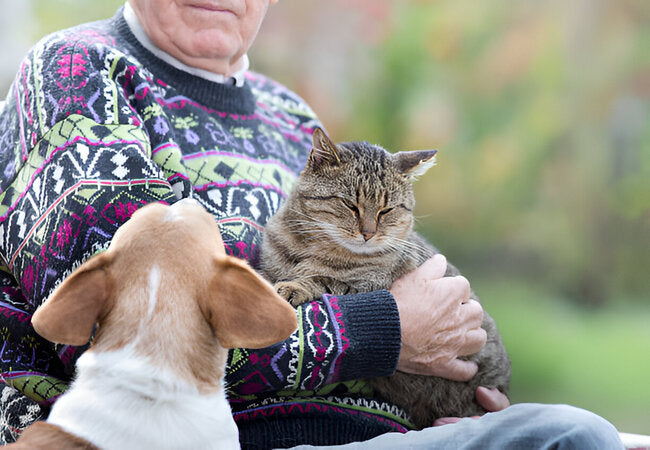Jealous Pets in 2025: Vet‑Approved Signs & How to Help 🐾

In this article
Jealous Pets in 2025: Vet‑Approved Signs & How to Help 🐾
By Dr. Duncan Houston BVSc
Does your pet act differently whenever you give attention to someone else? Whether you have one dog or a multi‑pet household, jealousy can be real and stressful. In this veterinary‑backed 2025 guide, I’ll explain how to identify jealousy in dogs and cats, understand why they feel this way, and offer science‑based, compassionate strategies to help them thrive. Along the way, I’ll highlight trusted tools and resources like the Ask A Vet app to support you and your pet ❤️🐶🐱
🐕🦺 9 Signs Your Pet Is Feeling Jealous
1. Aggression
Your pet may bite or nip another pet or person receiving attention to reclaim affection. However, rule out health issues—urinary accidents or sudden aggression can signal discomfort.
2. Clingy or “Velcro” Behavior
If your pet suddenly becomes more affectionate—following you, licking you, or demanding cuddles—it may be trying to regain your focus.
3. Pushy Interruption
Pet pushes between you and another being to monopolize your attention, often physically blocking access.
4. Growling or Defending Resources
Growls or fights with other pets—especially when someone else gets attention—are common in jealous pets.
5. Scaring Strangers or New Family Members
Barking, hissing, or aggression toward guests may stem from fear of losing your affection.
6. Attention-Seeking Tricks
Your pet may suddenly perform tricks or behaviors—like sitting, barking, or doing flips—to get noticed.
7. Invading Personal Space
Pets may lie on your keyboard or sit on your lap as you interact with someone else.
8. Withdrawal or Sulking
Jealous pets sometimes retreat or hide, showing they are upset.
9. House Soiling or Misbehavior
Thwarted pets might urinate or defecate indoors as a bid for attention, but rule out medical causes first.
🐱 Why Do Pets Get Jealous?
Veterinarians identify several root causes:
- Boredom or insecurity: When pets feel overlooked they crave interaction.
- Limited resources: One toy or bed for multiple pets triggers competition.
- Changes in routine or family: New baby, partner, or pet can upset dynamics.
- Stress or anxiety: Environmental changes or lack of exercise cause insecurity.
- Breed and personality: Some more territorial or clingy pets are predisposed.
🔧 2025 Vet‑Recommended Fixes for Jealous Behavior
1. Observe & Record Behavior
Keep a journal of when jealousy occurs—who/what is present, and how your pet behaves. Useful for vets or behaviorists.
2. Equal Attention Rituals
- Alternate petting, play, and praise between pets to ensure fairness.
- Give each pet solo quality time daily, 10‑15 minutes of focused attention.
3. Safe Spaces for Each Pet
Crates for dogs and refuge spaces for cats help pets feel secure. Personalized beds can reinforce comfort zones.
4. Separate Mealtimes and Toys
Feed pets apart and offer duplicate toys/beds. Keep high‑value items aside unless supervised.
5. Reward Calm Behavior
Catch your pet being good—calm, sitting or sharing—and reward with treats or praise. Reinforces positive calm behavior.
6. Calm Homecomings
Don’t heap attention on one pet when arriving. Pause briefly, then greet all pets calmly to reduce rivalry.
7. Leash Walks Together
Walk dogs together (with gentle leaders if needed), so they share experiences instead of compete.
8. Obedience & Confidence Training
Classes or one‑on‑one sessions support all pets—reducing insecurity and jealousy.
9. Introduce New Pets Slowly
When adding a new pet, follow scent swaps, short supervised visits, and gradual introductions. Pair rewards so the resident associates the newcomer with positives.
10. Seek Professional Help When Needed
If behaviors are aggressive or persistent, consult a veterinarian behaviorist. Anxiety meds or structured behavior plans can help.
🐾 Special Considerations for Cats
Cats show jealousy differently: hissing, litter-box issues, excessive grooming, or hiding. Offer elevated safe zones, environmental enrichment, and calm introductions to new pets or humans.
🧠 Releasing Energy & Enrichment
- Provide daily walks, play sessions, puzzle feeders, and mental challenges—essential for emotional balance.
- Rotate toys to maintain novelty.
- Leave soothing background sounds or companion radio during alone time.
- If you work long hours, consider midday visits or services like Woopf that can offer attention breaks.
🌟 Ask A Vet 2025 Support
Need guidance fast? With the Ask A Vet app, upload videos or logs of your pet’s behavior. Instant vet feedback helps determine if behavior changes are medical or emotional—and offers personalized advice 😊📱.
📝 Summary Table: Signs & Solutions
| Sign | Cause | Action |
|---|---|---|
| Clinginess | Insecurity | Equal attention, training |
| Aggression | Competition | Separate feeding, spaces |
| Attention tricks | Neglect | Catch & reward calmness |
| Withdrawal | Stress | Safe zones, enrichment |
| Resource guarding | Fear | Behaviorist, medicated plan |
❤️ Final Thoughts
Jealousy in pets often signals insecure emotions—not bad intent. With the right mix of structure, mental stimulation, and vet‑trust tools like Ask A Vet, you can build a confident, calm, and harmonious home environment. In 2025, delivering veterinary‑backed love and attention is easier than ever—your pets deserve it!
Need tailored help? Visit AskAVet.com or download the Ask A Vet app for 24/7 access to licensed veterinarians and behavior support.






